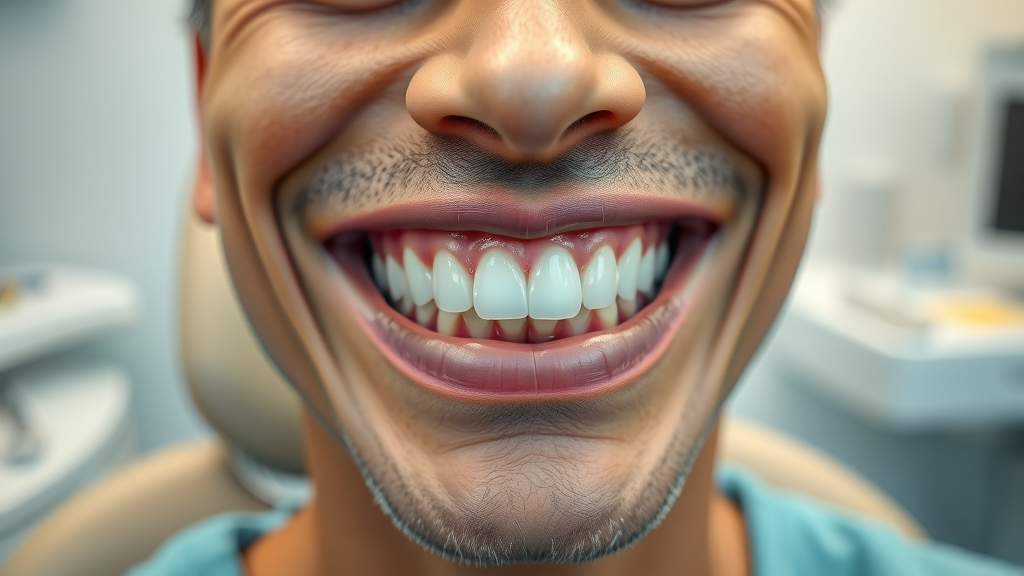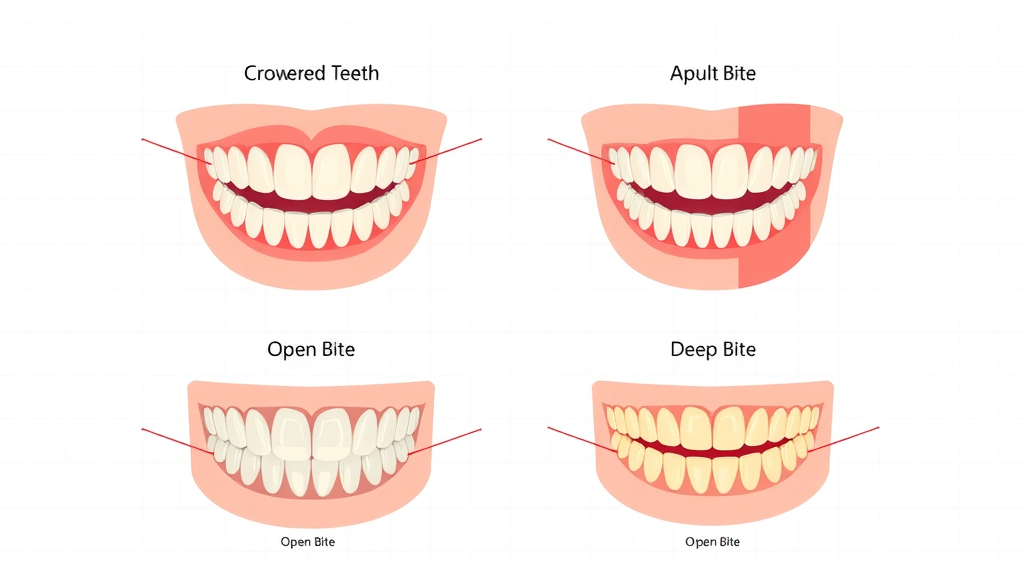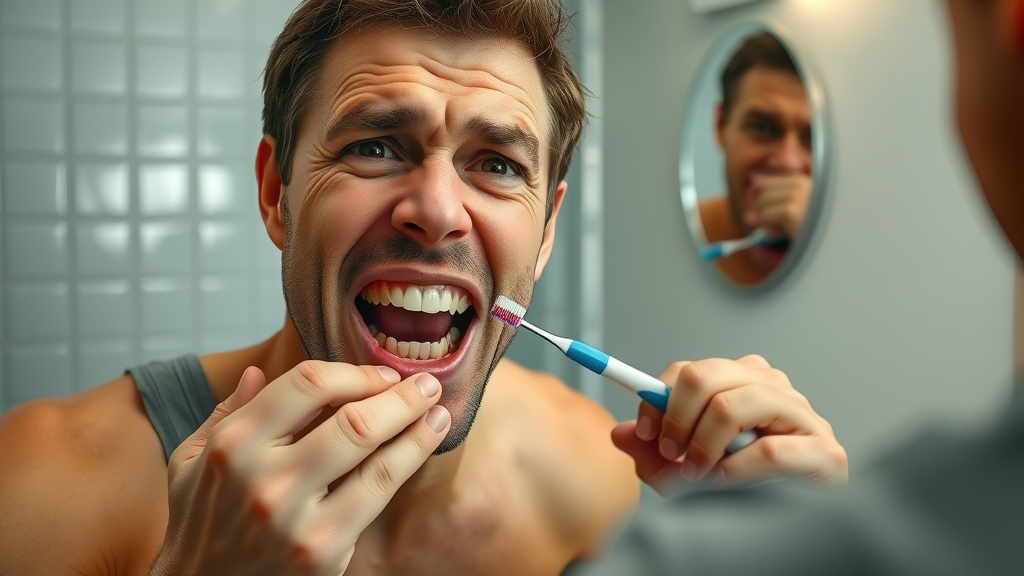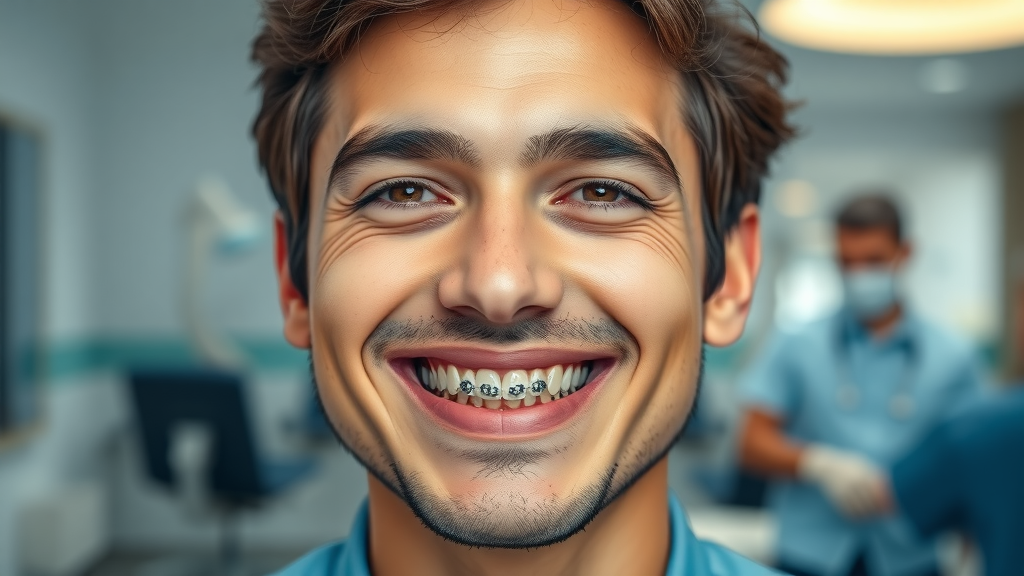Did you know that over one-third of adults struggle with crowded or misaligned teeth —often without even realizing the impact on their daily life? If you’ve ever wondered, “ Can braces fix crowding or bite issues in adults? ,” you’re not alone. Growing numbers of adults are seeking orthodontic solutions to boost their confidence and oral health. This evidence-based guide tackles your most pressing questions, busts myths, and reveals expert-approved treatment options, empowering you to achieve the beautiful smile and lasting health you deserve.
Shocking Facts: Adult Crowded Teeth and Bite Issues Are More Common Than You Think
"Did you know? Over one-third of adults suffer from some form of dental crowding or bite irregularity, affecting both oral health and confidence."

Many people assume that crooked teeth or bad bite problems only affect children and teens. In reality, adults make up a significant portion of those impacted by crowded teeth , overcrowded teeth , and complicated bite issues like open bite and deep bite . These conditions can develop over time due to age, loss of baby teeth, shifting of upper and lower teeth, or untreated childhood dental issues.
Crowded, crooked, or improperly aligned teeth can cause far more than cosmetic concerns. Persistent problems can result in jaw pain , gum disease , and even speech or chewing difficulties. Because adult teeth stop growing, these problems rarely resolve on their own and may become more severe if left untreated. That's why understanding adult orthodontic treatment options is vital for long-term oral health and well-being.
Breaking Down: Can Braces Fix Crowding or Bite Issues in Adults?
-
Explore the core benefits, risks, and solutions for adult orthodontic treatment, especially for crowded teeth and bite correction
The short answer is: Yes, modern braces and orthodontic treatments can correct crowded or misaligned teeth and bite problems for adults. Unlike previous decades, today’s orthodontic treatment options are less invasive, more comfortable, and designed with adults’ unique needs in mind. Addressing overcrowded teeth and bite irregularities (like open bite and deep bite), braces —including metal braces , ceramic braces , and clear aligners —offer reliable, proven results for adults at any age.
Each case is unique, and the best treatment plan depends on factors like severity, oral health, and lifestyle. For many adults, investing in correction leads not just to aligned teeth and a beautiful smile , but also to a better bite, easier cleaning, reduced risk of tooth decay , and less jaw pain . Understanding the differences between crowded teeth , crooked teeth , and various bite issues is the first step toward a healthier future.
|
|
|
Comparison of Common Adult Dental Issues |
|
Issue |
Description |
Risks if Untreated |
|---|---|---|
|
Crowded Teeth |
Teeth overlap or twist due to lack of space |
Tooth decay, gum disease, difficulty cleaning |
|
Crooked Teeth |
Upper and lower teeth misaligned or uneven |
Speech issues, jaw pain, uneven wear |
|
Overcrowded Teeth |
Extreme crowding, often with rotated or overlapped teeth |
Tooth loss, severe gum disease, jaw strain |
|
Open Bite |
Top and bottom teeth do not touch when mouth is closed |
Difficulty chewing, speech issues, jaw pain |
|
Deep Bite |
Upper front teeth excessively overlap bottom teeth |
Tooth wear, gum recession, jaw pain |

Understanding Crowded Teeth, Crooked Teeth, and Overcrowded Teeth in Adults
How Do Crowded Teeth and Crooked Teeth Affect Oral Health in Adulthood?
Crowded teeth and crooked teeth can have surprising impacts on your oral health . Because overlapping or twisted teeth create hard-to-reach gaps, brushing and flossing become much more difficult. This allows plaque and bacteria to build up, raising your risk of tooth decay and gum disease .
Poor alignment may cause strain on your jaw and surrounding muscles, leading to jaw pain or headaches. Additionally, upper and lower teeth that do not align correctly can lead to uneven wear on tooth surfaces—especially the front teeth and bottom teeth —making them more susceptible to damage and sensitivity over time. Fixing crooked and crowded teeth is not just about looks; it’s essential for maintaining long-term health.
Adults with misaligned teeth may also experience problems with their bite, such as bad bite or malocclusion . These issues can result in difficulty chewing, speech impairments, and in some cases, even digestive problems. A comprehensive orthodontic treatment plan addresses these concerns at the source, improving health and function as well as aesthetics.
What Happens If Overcrowded Teeth Are Left Untreated?
"Ignoring overcrowded teeth can increase your risk of gum disease and jaw pain."

If overcrowded teeth are left untreated, the consequences extend well beyond crooked smiles. Overlapping teeth can trap food and plaque, making it nearly impossible to maintain proper oral hygiene . The result? A heightened risk of gum disease , frequent cavities , and even tooth loss .
Furthermore, untreated overcrowding may lead to chronic jaw pain , excessive wear of certain teeth, and persistent bad breath. For many adults, this can also cause self-consciousness and reluctance to smile or speak in public. Over time, these dental issues often become more complex and costlier to address. That’s why adults with significant crowding should consider early orthodontic intervention —the longer you wait, the more complicated the treatment may become.
In severe cases, overcrowding can shift the position of the upper and lower teeth , affecting the alignment of the entire teeth and jaw system. This may contribute to a bad bite , which, if left untreated, increases the risk of joint disorders and might require more extensive corrective procedures later. Choosing timely orthodontic care can help avoid irreversible oral health damage.
Types of Bite Issues in Adults: Open Bite, Deep Bite, and More
Open Bite in Adults: Causes, Symptoms, and Risks
An open bite occurs when the upper and lower teeth don’t touch when the mouth closes—a gap remains even when you bite down. In adults, this condition often develops after years of thumb sucking, tongue thrusting, or due to genetic factors. It can also arise when baby teeth are lost early or because of jaw growth discrepancies.
Common symptoms of an adult open bite include visible space between your teeth when your mouth is closed, difficulty chewing certain foods, speech issues (like lisping), and often, facial asymmetry. Besides the functional problems, open bites also elevate the risk of tooth wear and jaw pain as other teeth compensate for the misalignment.
Left untreated, an open bite puts extra stress on specific areas of the mouth, leading to wear on the remaining front teeth or bottom teeth and increasing susceptibility to decay and gum disease . Collaborative orthodontic treatment —sometimes combined with surgery for severe cases—can offer long-term relief and functional improvement.
Deep Bite and Jaw Alignment Issues in Adults
A deep bite , also known as an overbite, is when the upper front teeth excessively overlap the lower front teeth. This is different from a normal bite, where the overlap is less pronounced and tooth wear is evenly distributed. Adults may develop a deep bite due to childhood habits, loss of back teeth, or natural changes in jaw and tooth positioning over time.
Deep bites can result in a range of symptoms, from teeth appearing shorter due to wear, to pain or pressure in the jaw joint. Left untreated, a deep bite will often accelerate the loss of tooth enamel, increase the risk of jaw pain , and cause receding gums on the lower teeth. In some severe cases, bite issues may make it harder to chew or speak comfortably and can even create facial changes.
Adult deep bites may be corrected with comprehensive orthodontic treatment , including braces or aligners, and sometimes with bite-correcting appliances or implants. Addressing these problems early can reduce the risk of dental complications and promote better oral health for years to come.
Orthodontic Treatment Options for Adults: Solutions for Crowding and Bite Issues
Traditional Metal Braces: How They Correct Crowded Teeth and Bite Issues

Traditional metal braces remain one of the most reliable options for correcting crowded teeth , overcrowded teeth , and a wide range of bite problems in adults. These braces consist of high-grade stainless steel brackets and wires that gently reposition teeth over time. Thanks to advances in design, today’s metal braces are smaller, more comfortable, and often work faster than earlier generations.
Metal braces are especially suited for even the most complex cases—such as severe overcrowding or challenging bite corrections—because of their strength and precise control. Adults considering metal braces can expect regular adjustments by an orthodontic specialist , and while treatment may last anywhere from 18 months to three years, the results are both long-lasting and transformative.
It’s important to note that, for adults with gum disease or jaw pain , extra care is required when planning treatment. Experienced orthodontists monitor oral health closely and can collaborate with general dentists or periodontists if necessary.
Ceramic Braces for Adults: A Discreet Orthodontic Option
Ceramic braces offer a discreet alternative for adults keen on correcting crooked teeth or crowded teeth without the visibility of metal. Instead of stainless steel, ceramic braces use tooth-colored or clear brackets that blend seamlessly with natural teeth. While they function similarly to metal braces, this style is particularly popular among adults who prioritize appearance in professional or social settings.
Ceramic braces are suitable for most adult orthodontic treatment plans, effectively treating everything from moderate crowding to complicated bite issues. They may be slightly more delicate than metal braces—requiring careful maintenance to avoid chipping or staining—but when paired with an experienced orthodontist, they deliver precise, subtle correction.
Keep in mind that, while ceramic braces can handle most cases, they’re not always recommended for the most severe case of overcrowding or jaw alignment problems. Your orthodontist will help you decide if this treatment option is right for your needs and lifestyle.
Clear Aligners: Modern Solutions for Overcrowded and Crooked Teeth
Clear aligners —like Invisalign and similar systems—have revolutionized orthodontic care for adults. These custom, virtually invisible trays gently move crooked teeth and correct mild to moderate bite issues. Because aligners are removable, you can eat, brush, and floss as usual, decreasing your risk for tooth decay and gum disease during treatment.
Clear aligners are particularly effective for less complex cases of crowded teeth , providing subtle, nearly invisible correction over time. The treatment is generally comfortable—without the irritation sometimes seen with metal or ceramic braces. Progress requires wearing the aligners 20–22 hours daily and switching trays every 1–2 weeks based on your specific treatment plan .
However, severe overcrowded teeth or significant bite problems may still require traditional braces, possibly combined with auxiliary appliances for the best outcomes. Consulting an orthodontic specialist will ensure you choose the most effective treatment option for your case.
-
Metal Braces: Strong and effective for all levels of severity; sometimes visible and may require dietary changes.
-
Ceramic Braces: Less noticeable and suitable for most adults; slightly more delicate and can stain without careful cleaning.
-
Clear Aligners: Nearly invisible, comfortable, and removable; ideal for mild to moderate issues, not recommended for severe cases.

Special Considerations: Severe Cases and Complex Adult Bite Correction
When Is Specialist Orthodontic Treatment Necessary for Severe Cases?
Some adults present with severe case overcrowding, badly misaligned jaws, or complex bite problems that demand advanced intervention. In these situations, treatment might include a combination of braces , specialty appliances, or even orthognathic (jaw) surgery to achieve full correction. Adult cases are often more challenging because jawbones have stopped growing, requiring careful planning and expert execution.
Referrals to orthodontic specialists may be necessary when prior dental work (such as crowns or implants) complicates treatment, or when underlying health issues affect the gums or bone structure. If you’ve been told your case is too severe, don’t lose hope—innovations in adult orthodontics now make it possible to achieve significant improvements even in the most difficult scenarios.
During your assessment, expect your orthodontist to collaborate with a general dentist or other dental professionals as needed to ensure comprehensive care and a successful outcome.
Gum Disease and Jaw Pain in Adults Pursuing Orthodontics
Adults seeking orthodontic treatment for crowded teeth or jaw issues must consider the health of their gums and supporting bone. Gum disease is more common in adults than in children and, if left untreated, can delay or complicate orthodontic procedures. Regular professional cleanings and periodontal care are crucial before and during treatment.
Jaw pain sometimes occurs in adults during realignment, particularly if bite issues like open bite or deep bite have placed prolonged stress on the jaw joint. Experienced orthodontists monitor for these complications, adjusting the treatment plan as needed to minimize discomfort and avoid damage to the temporomandibular joint (TMJ).
Remember, proactive management of gum and jaw problems leads to more predictable results and a safer, healthier orthodontic experience.
People Also Ask
Can braces fix an open bite in adults?
Braces—sometimes in combination with other orthodontic treatment options —can improve or fully correct most open bite issues in adults, though severe cases may need advanced care or surgery.
How do you fix overcrowded teeth in adults?
Overcrowded teeth in adults are most commonly fixed with braces or clear aligners ; extraction or reshaping may be required in severe cases .
How do you fix a deep bite in adults?
Deep bite correction in adults generally involves braces, clear aligners, and bite-correcting appliances. Some severe case treatments may require surgery.
When is it too late to get braces?
It is almost never too late for orthodontic treatment as long as gums and teeth are healthy enough. Adult orthodontic treatment is possible at nearly any age.
Practical Steps: Starting Orthodontic Treatment as an Adult
-
What are my specific dental issues: crooked teeth , crowding , overbite , or open bite ?
-
What treatment options are best for my case—metal braces, ceramic braces, or clear aligners?
-
How will my treatment plan be affected if I have existing crowns, implants, or previous dental work?
-
Will I need extractions or other procedures before treatment?
-
How long will my orthodontic treatment take?
-
What special oral hygiene steps should I follow during treatment?
-
What is the estimated cost, and does my dental insurance cover it?
-
Are there local specialists experienced with adult severe case corrections?

Expert Insights: Long-Term Benefits and Challenges of Correcting Adult Crowding and Bite Problems
"A balanced bite and aligned teeth improve not just your smile, but your overall health for decades to come." — Dr. Elena Lopez, Board-Certified Orthodontist
The journey to a straighter smile in adulthood isn’t always easy, but the benefits last a lifetime. Adults who pursue orthodontic treatment often report greater self-confidence, improved speech and chewing, and a notable reduction in jaw or gum pain. Equally important, well-aligned teeth are easier to clean and maintain, meaning fewer cavities and lower risk of gum disease as you age.
However, adults may face challenges such as slower tooth movement and heightened risk of bone or gum loss from previous dental issues. Working closely with a skilled orthodontist ensures that these hurdles can be managed. In most cases, the functional, cosmetic, and dental health benefits strongly outweigh the short-term investment of time and effort.
Correcting adult crowded teeth and bite problems truly does mean investing in a healthier, brighter future—for both your smile and your overall wellbeing.
Frequently Asked Questions on Can Braces Fix Crowding or Bite Issues in Adults?
-
Do braces work for adults with severe dental issues? — Yes, especially with modern options and comprehensive planning, most adults see substantial improvement, even in complex or severe cases.
-
How long does adult orthodontic treatment take? — Treatment generally ranges from 12 to 36 months, depending on case complexity and chosen method.
-
Are results permanent? — With proper retainers and oral care, results can last for decades. Regular follow-ups are important.
-
Can I get braces if I have crowns or missing teeth? — Often, yes. Your orthodontist can tailor solutions for adults with previous dental work.
-
What is the best treatment for discreet results? — Ceramic braces and clear aligners are popular choices for adults who want subtle correction.
-
Will adult braces hurt? — Some discomfort is common initially, but most adults adjust quickly. Your provider can help you manage any pain.
Key Takeaways: What Every Adult Must Know About Braces for Crowded or Crooked Teeth
-
Braces and clear aligners are effective treatment options for adult crowded teeth and bite issues.
-
Many adults benefit from orthodontic treatment, with improved appearance and better dental health.
-
Severe cases of misalignment often require comprehensive or multidisciplinary approaches.
Ready for a Healthier, Straighter Smile? Subscribe Now for the Latest on Adult Orthodontic Solutions
Subscribe now to get the latest Grand Strand orthodontic guides, tips, and updates — right to your inbox. No spam. Just smiles.
Addressing crowded teeth and bite issues in adults is not only possible but also beneficial for both oral health and self-confidence. Traditional braces have long been a reliable solution for correcting severe crowding and complex bite problems. For those seeking a more discreet option, clear aligners like Invisalign offer an effective alternative for mild to moderate cases. Additionally, ceramic braces provide a less noticeable treatment method, blending with the natural color of teeth. It’s important to consult with an orthodontic specialist to determine the most suitable treatment plan tailored to individual needs.
 Add Row
Add Row  Add
Add 



Write A Comment